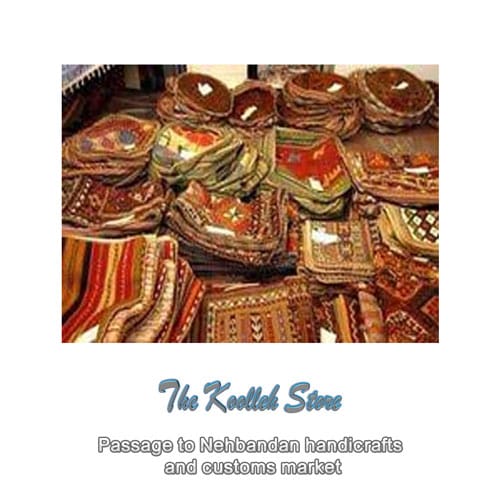Passage to Nehbandan handicrafts and customs market

According to the ancient documents of Nehbandan region, the habitat of one of the Aryan tribes named Sagart was that in the south of Khorasan due to the special climate and climatic has not been much attention and invasion by foreigners and the language and race of the people of this region It is less mixed and mixed, so since the dominant ethnicity in the Persian region is the official and main language of the Persian people. This language is spoken in different parts of the city with special dialects attributed to the same place. Such as dialects, Urdu, Nahi, Shusafi, which of course are accompanied by differences in words, sentences and emphasis on syllables.
Most of the Arab tribes living in the area still speak their own language. Among the cultural characteristics of the people of Nehbandan, we can mention the celebration of Thanksgiving in agriculture, the celebration of Quj and fragmentation and migration in animal husbandry, the celebration of Nowruz, the sight of visiting, the ceremony of Barat, the month of Muharram and the recitation of taziyeh.
Among the common games that have their own fans in the region and have been considered, we can mention the marble game (marbles), including the game, wood game and the seven stones of the ruined Kot Kot game.
Sidal and Meghan towel weaving; Vanguard of art in Nehbandan
Nehbandan handicrafts include carpet and rug weaving, traditional dyeing, towel weaving, local clothing, wicker weaving, masonry (traditional blacksmithing), mat weaving, pottery and jajim weaving, which we briefly introduce in this report.
Glim weaving has a long history as the first underlay, it has an easier weaving method compared to carpets, it is also cheaper. Creativity, initiative and innovation in designs and colors have introduced kilim as a more artistic discipline than carpet, the taste and creativity of Iranian villagers and nomads play a significant role in its production.
In the definition of kilim, it should be said that it is a kind of carpet without lint with woolen thread, cotton or treasure for underlayment, which is woven with a combination of warp and weft and with many ornaments.
One of the most important villages and places that are active in kilim weaving is Siah Khonik, Sidal, Meighan, Arabkhaneh area, Stand, Chahdashi, Dehsalam.
Jajim weaving has a long history in Nehbandan and has played a very important role in the self-sufficiency of the people of this region. Jajim, locally called Jajim, is one of the special arts of the Kurdish and Turkish regions that can be found in most parts of Iran today.
Jajim is a handicraft that resembles a plus and a kilim with colored striped patterns that, like other handicrafts, is used as a base. It has no fluff and is woven from colored cotton or wool yarns.
Chair quilts, rugs, bread tablecloths, rugs, rugs, all kinds of women’s bags and slippers are some of the functions of Hajim. This art was popular in most parts of Nehbandan until a few years ago, but today it is still flourishing in Sidal, which can be mentioned as the center of Nehbandan jajim weaving. Towel weaving, which was a kind of traditional fabric in the past, was common in different parts of Nehbandan, and the most important villages in which this traditional textile industry is now established are Sidal and Meygan.
Pottery production center in Nehbandan
Mat weaving or mat weaving is one of the most important handicrafts and perhaps the oldest of them. The samples obtained in Mesopotamia and Africa prove that mat weaving and basket weaving were not only the origin of textiles but also pottery or pottery. Documents are available. Which shows that the first human substrates were made of reeds and plants that grew in the lower swamps of Mesopotamia, and the first shelters after living in caves were created with the help of mats and reeds.
Mat weaving in Nehbandan using palm leaves is especially popular in Dehsalam village, whose products include baskets and baskets, mats in circular and oval shapes, decorative animals such as camels and shillings (food storage).
Wicker weaving in Ghadmagah, Astonand, Alvand, Siah Khonik, Chahar Farsakh, Samafa, Sultanabad and Bichand has a long history of several hundred years due to the existence of the Red Mountain Range (Bobak), which is the main source of raw materials for this industry. For weaving all kinds of baskets, almond wood (almond, almond) is used, which has a delicate and thin wood with high flexibility.
Pottery in Nehbandan region has a very practical aspect. The village of Astonand is one of the old areas for making pottery, which until a few years ago was the center of production of various types of Nehbandan pottery, and the people of this area mostly knew the pottery by the name of the same village.
Masonry is another handicraft that has a historical history and even more than Islam in Nehbandan. The existence of horses in the region and their long history show that this art has been popular in the region for a long time and stone carving and ascotti are examples of this art. Among the most important stone tools in the region, we can mention the stones of horses, hand ace stones, vases, sugar bowls, mortars, clothes showers, water basins, water pipes, etc. The mine for making this type of utensils was Khonik Sofla village and three farsakhs. Challengari or (traditional blacksmithing) is another handicraft that dates back to Turanian women and existed in most villages of Nehbandan. Among the people who have taken up this job so far is Karbalaei Hussein, in the village of Kalateh Sorkh Shah Kooh and Siah Khonik.
Fireman, neck collar, two horns and four horns, all kinds of long nails, sugar cutters, sugar breakers, chains, pickaxes, bells, locks, horseshoes, plows, sickles, etc. are his most important products with various designs and designs. It adds to the beauty of his works.

